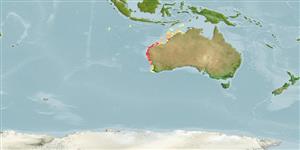>
Syngnathiformes (Pipefishes and seahorses) >
Syngnathidae (Pipefishes and seahorses) > Syngnathinae
Etymology: Hippocampus: Greek, ippos = horse + Greek,kampe = curvature (Ref. 45335); montebelloensis: Named in reference to the Monte Bello Islands, its type locality..
Issue
Kuiter described the species (2001) and endorsed it subsequently (2009) separating it from Hippocampus zebra Whitley, 1964, while Lourie (in two publications in 2016) synonymized it with the latter species. We chose to assign an uncertain status because probably it is a case of sibling species (Kuiter) while we recognized a lack of clear evidence (Lourie) to separate them. Genetic studies have to be performed to take a documented decision.
Environment: milieu / climate zone / depth range / distribution range
Ecologia
marinhas; não migratória. Tropical
Eastern Indian Ocean: known only from Monte Bello Islands and Exmouth Gulf, Western Australia.
Tamanho / Peso / Idade
Maturity: Lm ? range ? - ? cm
Max length : 7.8 cm OT (female)
Descrição suscinta
Morfologia | Morfometria
Espinhos dorsais (total): 0; Raios dorsais (total): 18-19. Trunk rings 11; tail rings 37; subdorsal spines 3/0,1,0; spine above eye of moderate size, length about pupil-diameter, slightly angled back; moderately large and recurving lateral head spine; long, forward-directed nape spine; nose profile straight; coronet moderately high, with spines on corners, posterior 3 largest and directed backward; 3 spines of moderate size on shoulder ring, uppermost and central spines at end of pectoral-fin base, lowermost ventrally; superior trunk ridge with spines of small to moderate size on rings 1, 4, 7 and 11, extended by long dermal flaps at spine tips in holotype; superior tail ridge similar to superior trunk ridge, with enlarged spines at regular intervals, becoming progressively smaller posteriorly (Ref. 42735).
Found on the continental shelf (Ref. 75154). Holotype caught at the surface, clinging to Sargassum fragment (Ref. 42735). Maximum length is based on a straight-line length measurement from upper surface (ignoring spines) of first trunk ring, to tip of tail (Ref. 42735). Ovoviviparous (Ref. 205). The male carries the eggs in a brood pouch which is found under the tail (Ref. 205).
Ciclo de vida ou comportamento de acasalamento
Maturidade | Reprodução | Desova | Ovos | Fecundidade | Larvas
Male carries the eggs in a brood pouch (Ref. 205).
Kuiter, R.H., 2001. Revision of the Australian seahorses of the genus Hippocampus (Syngnathiformes: Syngnathidae) with descriptions of nine new species. Rec. Aus. Mus. 53:293-340. (Ref. 42735)
Status na Lista Vermelha da UICN (Ref. 130435)
Warning: mysqli::__construct(): (HY000/1040): Too many connections in /var/www/html/includes/func_getlabel.php on line 46
Can't connect to MySQL database (fbapp). Errorcode: Too many connections
